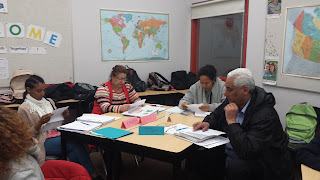Hi there! I haven't been posting here because I started a new job as an Educational Developer in February 2020. Even though I am not teaching anymore, I decided to keep this blog for now.
The post below was a draft left forgotten in 2019 that I have decided to post because it might help someone. :-)
Cheers,
Cintia
________________________________________________________________________________
We start the class with a question related to the topic of the day and the students have the opportunity to say something in English. I ask a question and answer it to model it for students. Then I ask them to repeat it so I can write it on the board. (I make sure to include discourse markers - uh, well, let me see - because I want to teach my student spoken English too). I ask each student the question and I write their answers on the board.
What is your favourite food?
Uh, my favourite food is pizza.
lasagna.
soup.
vegetables.
I ask them if they understand all the words, explain or show the images on Google images (I am lucky to have a Smartboard in my classroom) and then we repeat everything. I can see the students really like this activity because it wakes them up and gives them all a chance to say something in English. As I mark the attendance, they copy it.
After that, we have a warm up activity that can be playing some vocabulary online games, putting some sentences in the correct order using the Smartboard, doing a TPR activity or other activities.
Then, I ask a student to help me distribute the name tags (I do this after 4 or 5 weeks of class). They come to the front of the class and ask "Is ______ here?" , classmates "Yes, good morning, ______." This gives a chance for them to practice the structure "Is ____?" and become used to speaking English in front of people. (On a side note, one of my students told me she would cry when called to be in front of everyone when she was younger, now she always volunteers to be in front of her classmates).
After that, I ask another student to set the calendar. The volunteer asks "What day is today?", students answer "Today is January 30th, 2019".
Then, I ask a student to read the message of the day including the agenda. After that, the students read the underlined phrases of the agenda for me to write on the board.
I also teach them everyday expressions so they can use them in class and everywhere. I stick one sentence or phrase a day on the wall so they can have plenty of time to acquire the language. I fell very happy when they use the expressions regularly.
As they always ask me to learn vocabulary, I have decided to teach them the most frequent spoken and written words. I believe this is going to help them use English outside the class in the everyday situations. They copy these words on lists and write sentences with the word. Then, on Friday, I give them index cards so they can write the 5 written words of the week. They write a word in each card, its translation and a few sentences. On the following Monday, they have a dictation of a text about one of the students using the words learned the previous week. They always enjoy listening to their lives.
After this routine, we review the previous class and have the new activities of the day including contextualized grammar, watching short videos, playing games, reading texts, doing various exercises, listening to audios, and so on.
After a few weeks using this routine, I can see the positive results in my students' learning. They use the everyday expressions, the vocabulary and become more comfortable in class.
Do you have a class routine too?











































